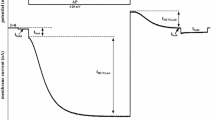Abstract
Full-grown frog ovarian oocytes (Rana esculenta), were voltage clamped with a conventional two-microelectrode system. Depolarizations from a holding potential of −60 mV produced slowly developing outward currents. Two-step clamp experiments showed that, in Ringer's solution, this current has a reversal potential at about −84 mV. Substitution of either sodium or chloride with impermeant ions in the external solution did not alter significantly the activation of the current nor its reversal potential. Increasing the potassium ions concentration caused a shift on the reversal potential in the positive direction with a slope of about 48 mV per decade. The presence of TEA ions (50 mM) in the external solution partially reduced the current. It is concluded that the membrane of full-grown frog ovarian oocytes possesses voltage-dependent ionic channels permeated mainly by potassium. They appear to play an important role in the control of membrane potential.
Similar content being viewed by others
References
Barish ME (1983) A transient calcium-dependent chloride current in the immatureXenopus oocyte. J Physiol 342:309–325
Baud C, Kado RT, Marcher K (1982) Sodium channels induced by depolarization of theXenopus laevis oocyte. Proc Natn Acad Sci USA 79:3188–3192
Grey RD, Wolf DP, Hedrick JL (1974) Formation and structure of the fertilization envelope inXenopus laevis. Develop Biol 36:44–61
Hagiwara S, Yoshida S, Yoshii M (1981) Transient and delayed potassium currents in the egg cell membrane of the coelenterate,Renilla koellikeri. J Physiol 318:123–141
Hodgkin AL, Horowicz P (1959) The influence of potassium and chloride ions on the membrane potential of single muscle fibres. J Physiol 148:127–160
Kusano K, Miledi R, Stinnakre J (1982) Cholinergic and catecholaminergic receptors in theXenopus oocyte membrane. J Physiol 328:143–170
Maeno T (1959) Electrical characteristics and activation potential of Bufo eggs. J Gen Physiol 43:139–157
Miledi R (1982) A calcium-dependent transient outward current inXenopus laevis oocytes. Proc R Soc B 215:491–497
Miyazaki S (1979) Fast polyspermy block and activation potential. Develop Biol 70:341–354
Miyazaki S, Hirai S (1979) Fast polyspermy block and activation potential: Correlated changes during oocyte maturation of a starfish. Develop Biol 70:327–340
Morrill GA (1965) Water and electrolyte changes in amphibian eggs at ovulation. Expl Cell Res 40:664–667
Morrill GA, Ziegler D (1980) Na+ and K+ uptake and exchange by the amphibian oocyte during the first meiotic division. Develop Biol 74:216–223
Narahashi T (1974) Chemicals as tools in the study of excitable membranes. Physiol Rev 54:813–889
O'Connor CM, Robinson KR, Smith LD (1977) Calcium, potassium and sodium exchange by full-grown and maturingXenopus laevis oocytes. Develop Biol 61:28–40
Palmer LG, Century TJ, Civan MM (1978) Activity coefficients of intracellular Na+ and K+ during development of frog oocytes. J Membrane Biol 40:25–38
Peres A, Bernardini G (1983) A hyperpolarization activated chloride current inXenopus laevis oocytes under voltage clamp. Pflügers Arch 399:157–159
Schlichter LC (1983a) Spontaneous action potentials produced by Na+ and Cl− channels in maturingRana pipiens oocytes. Develop Biol 98:47–59
Schlichter LC (1983b) A role for action potentials in maturingRana pipiens oocytes. Develop Biol 98:60–69
Schlichter LC, Elinson RP (1981) Electrical responses of immature and matureRana pipiens oocytes to sperm and other activating stimuli. Develop Biol 83:33–41
Wallace RA, Steinhardt RA (1977) Maturation ofXenopus oocytes. II. Observations on membrane potential. Develop Biol 57:305–316
Ziegler DH, Morrill GA (1977) Regulation of the amphibian oocyte plasma membrane ion permeability by cytoplasmic factors during the first meiotic division. Develop Biol 60:318–325
Author information
Authors and Affiliations
Rights and permissions
About this article
Cite this article
Peres, A., Bernardini, G., Mancinelli, E. et al. A voltage-dependent K+ channel controlling the membrane potential in frog oocytes. Pflugers Arch. 403, 41–46 (1985). https://doi.org/10.1007/BF00583279
Received:
Accepted:
Issue Date:
DOI: https://doi.org/10.1007/BF00583279




